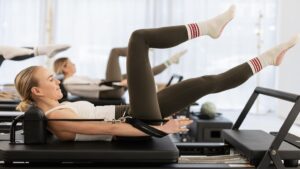
The Basement Gym + Studio opens in Camden Town
Camdenist readers get 50% off their first month’s membership, too

The Francis Crick Institute is a looming spectacle, swooping in between the British Library and St Pancras International. From the inside, it’s even more impressive; a clinical lasagne of labs, offices, bright lights and minds, piled up high into the sky. The Institute’s latest free exhibition, Cut + Paste, developed in collaboration with The Liminal Space, is on the ground floor as you come in through the revolving doors.
After an accessible introduction to genome editing, visitors are gently guided towards some of the questions being considered by scientists and society at large. Colourful boards and interactive props encourage you to explore, and then share, your thoughts in dialogue with other visitors, as well as with the Institute itself. You can also read and listen to other people’s reflections, both entertaining and concerning.
In conversation with Güneş Taylor, a postdoctoral research scientist in the Lovell-Badge Lab at the Crick, we find out more about this remarkable technology and why everyone should visit the exhibition.

What is genome editing, in simple terms?
It’s a type of tool that allows us to change DNA, to cut and paste it. In itself, that doesn’t mean a great deal, but if you understand how much DNA shapes the world that we live in, the ability to edit is really exciting and important to think about.
Are there any circumstances in which you would edit your own DNA?
Yeah, sure! If I needed to, and if it was possible. You’ve highlighted a really important difference in the context under which genome editing can be used: in a heritable way, or in a somatic way. Soma means body, so you can use this technology to edit bodies that already exist, or you can do it in a way that means that your eggs and sperm will carry that edit on into the future. For me right now, because I already exist, only somatic editing is possible, I can only change the cells in my body.
There’s a really big delivery problem, because we’re made up of like 30 trillion cells and all of them have DNA in. So, it’s kind of hard to edit them all, to do whatever it is that you want to do. Right now, I couldn’t be like, you know what, I want to be stronger, let’s edit all of my muscle cells, that’s not going to be possible. But if say, for example, I got blood cancer, it would be possible to take the stem cells out of my bone marrow to edit them and then you can do a bone marrow transplant. You could theoretically cure my leukemia, if I was to get that in the future. So, under circumstances like that, absolutely. Sign me up.

Do you think we have a moral responsibility to let people die, to be mortal, or to eradicate as many diseases as possible and ease suffering, if we can?
I don’t know if The Francis Crick Institute has an official position on that. My sense is that, we’re a biomedical discovery institute, we are in the business of finding out about and understanding life. The decisions about what to do with that information are beyond the scope of us in a lab. So moral obligation is a big phrase. It’s something that has to be decided through the conversations of many people. Importantly, it will be culture specific, context specific, people have very different opinions on this matter.
What do you think are the most exciting things about this technology? And the most challenging?
I’m a research scientist, so for me the most exciting thing about this technology is the fact that it’s made doing really clean experiments possible, where we can very precisely ask questions about very specific pieces of DNA. That’s what my job is about, understanding how DNA impacts how ovaries are formed. That’s how I do my research. This has changed the way we do research. It’s really improved it and completely broadened our horizons, which is great, but that’s not really going to be relevant to anyone else outside of science in the immediate sense.
I think what’s really cool about this technology is that we’ve been working for a long time to understand biology and will continue to and this tool, for the first time ever, really makes possible a future where we can use that knowledge in a meaningful sense. It’s important to be able to have that option on the table because knowledge has to be considered for use, or else it’s pointless to have.

What do you think are the biggest questions that should be asked in this space?
Genome editing allows this technology to exist, which means that the ability to edit DNA exists, which means that everyone has to start asking the question, what do I feel comfortable with changing? And I think a lot of people feel quite uncomfortable with changing anything. There’s a commitment barrier there. We have to get comfortable with that. The reality is, we as human beings have already changed a lot about the world around us, about the animals around us, about human bodies even and how we live our lives. This technology just changes how active we feel in the process.
Why should everyone come and see this exhibition?
For two reasons. It’s important to be informed about something as wide reaching as the impact of this technology. A lot of people feel like science is beyond them and that’s not the case. We all understand what inheritance is about. In terms of traits, we all understand those kinds of concepts. We also all know about selective breeding and how that’s shaped our food chains, our agriculture, the pets that we have in our lives. This technology is going to impact all those things that our entire world is built upon. It’s important to know about it.
The second reason is that this is a unique opportunity for people to come and make their mark in a place that is actively listening. The Crick is actively listening to what people come and say or write down in this space. It’s an opportunity to potentially make a change, to have an actual impact on how, at least, this research institute thinks and talks about genome editing going forward.
Cut + Paste is open and free to visit at The Francis Crick Institute until 2nd December 2023.

Camdenist readers get 50% off their first month’s membership, too

A brand new hairdressing and barbering academy has landed in Camden Town and is now seeking style-conscious models and enthusiastic trainees

We speak to founder, Sol, about bringing the studio to Kentish Town

Explore the neighbourhood’s brand new neighbourhood